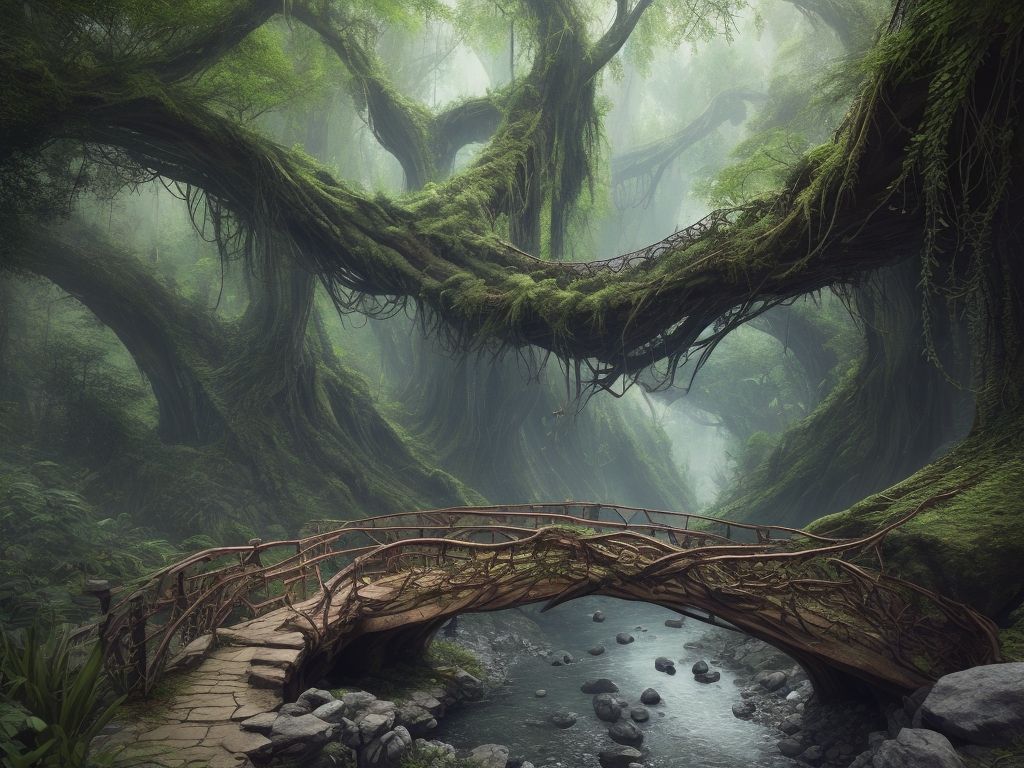A symbol that showcases the harmonious relationship between man and nature
Tucked away in the remote hills of Meghalaya, India, you'll find a true wonder of traditional Khasi engineering: the living root bridges.
These structures are skillfully crafted from the aerial roots of the rubber fig tree. And they showcase an amazing blend of human creativity and the wonders of nature.
They're a true testament to the ingenuity and resilience passed down through generations.
So, let's take a closer look at the history, construction and significance of these unique bridges.
What is a living root bridge?
Unlike regular bridges made of steel or concrete, living root bridges are built using living plant roots. It's a pretty amazing concept that's both sustainable and perfectly suited to the local conditions. That's what makes Meghalaya stand out in the world of bioengineering.
The "living" in their name is more than just a fancy label. These organic structures keep on growing and getting stronger over time. Requiring minimal maintenance or repairs (as long as they're well cared for).
To really understand the living bridges, you must have an appreciation for the unique bioengineering at play.
The Khasi and Jaintia tribesmen skillfully guide the long, flexible roots of rubber fig trees across rivers. Using hollowed-out betel nut trunks as root-guidance systems. It's pretty impressive how they make it happen.
But here's the thing: building a bridge like this takes a whole lot of foresight, patience, and attention to detail. As time goes by, those roots grow thicker and weave together. Creating a solid bridge you can walk on.
And these bridges aren't just regular structures. They're living beings that adapt and react to their surroundings.
The roots of the rubber fig trees can find water sources. Making sure the bridge stays hydrated and strong. Even in dry seasons.
Moreover, the living bridges aren't bound by a specific size or shape.
As the roots continue to grow and spread, the bridge can expand and meet the needs of the community. This unique feature sets living bridges apart from their static counterparts. Because it offers a dynamic and ever-evolving solution to the challenges of crossing rivers.
The history and evolution of living root bridges
The history of living bridges is closely connected with the tribal cultures of Meghalaya.
They're an age-old answer to the constant isolation caused by monsoon rains. When heavy downpours made rivers impossible to cross, it made communication between distant villages a real challenge.
Over centuries, these living bridges have transformed from simple survival tools to integral components of the community's cultural and architectural identity. They're not just functional structures. But also symbols of the harmonious bond between humans and nature.
Every living bridge has a story to tell. Carrying the wisdom and knowledge passed down through generations. The process of building and maintaining these bridges has been handed down through oral traditions. Keeping the art of creating living bridges alive and vibrant.
These bridges have become iconic attractions, drawing visitors from all over the globe who are in awe of their clever design and stunning natural charm. They stand as a testament to the creativity and strength of the Khasi and Jaintia tribes, who have cherished and fostered this incredible architectural form for centuries.
Today, the living bridges are still loved and celebrated as living symbols of sustainability and community collaboration. They show us the incredible potential when nature and people work together. Reminding us of the endless possibilities we can achieve when we're in sync with our environment.
What is the cultural significance of living root bridges in Meghalaya?
Living bridges are a vital part of Meghalaya's cultural fabric. Showing how the indigenous tribes and their environment work together.
They represent the tribes' strength, wisdom, and ability to adapt. Teaching us valuable lessons about survival through collaboration.
These bridges are more than just transportation infrastructure. They're also social connectors, bringing people together, fostering cultural exchange, and strengthening community bonds across generations.
Living root bridges play a big role in local communities
Besides being important connections between isolated villages, these bridges also have a big role in local customs and traditions. Each living bridge, with its own distinct look and age, holds countless stories and folklore that the community truly treasures.
They're places where people come together to work, hang out, and even take part in sacred rituals. They bring communities closer and help preserve cultural identity.
Living root bridges are a symbol of Meghalayan heritage
Today, these living bridges are like ambassadors of Meghalayan heritage, captivating people worldwide. With their exceptional construction and ecological harmony, they ignite the imagination, attracting tourists and researchers alike.
And they represent Meghalaya's unmatched bioengineering techniques, highlighting the state's impact on sustainable construction methods.
And what's the construction process of living root bridges?
Constructing a living bridge takes time and dedication. It's a unique form of craftsmanship that evolves over generations. And combines knowledge of the local environment and bioengineering principles.
It takes a mix of patience, skill, and foresight. Forming an unspoken agreement of determination between those who came before and those yet to come.
The materials and techniques they use
The main material used for building these bridges is the aerial roots of the Ficus Elastica (or the Indian rubber fig tree). They're super strong, grow fast, and don't rot easily. This makes them a perfect choice for bridge construction.
The roots are guided by hollowed-out betel nut trunks or bamboo scaffolding, sort of like a mold. Over a few years, these roots weave together and create a strong, living bridge.
The time and effort involved
Creating a living bridge is a true labor of love that takes decades to complete. It usually takes about 10 to 15 years for a bridge to form. And even longer for it to be strong enough to support people.
Yet, the effort is a worthy investment. Once they're built, these bridges can last for several hundred years. Way longer than any man-made structure could handle.
Living root bridges have an impact on the environment
The living bridges make a big contribution to their surrounding ecosystems. They're green structures that support the region's diverse wildlife. While standing as symbols for sustainable architecture.
They make a strong case for reconsidering our connection with nature. Demonstrating that we can collaborate with it instead of opposing it.
How living root bridges promote sustainability
Living bridges use a zero-waste approach to construction. Taking advantage of natural resources without causing harm or depletion. Their roots play a crucial role in stopping soil erosion. And the thick foliage creates cozy homes for all sorts of animals, promoting biodiversity.
Plus, these bridges are very adaptable to environmental changes, totally unfazed by climate variations or natural disasters. They offer a sustainable and low-maintenance option compared to traditional building materials.
How do living root bridges and local ecosystems interact?
Living bridges represent a unique form of symbiosis between flora and man-made structures.
Their presence has a positive impact on the local ecology. They help mosses, ferns, and orchids thrive. While also creating homes for insects and birds.
Their existence shows that architecture can peacefully and positively coexist with nature. Without causing any disturbance or harm.
How can I explore Meghalaya’s famous living root bridges?
Meghalaya's living bridges are not only incredible engineering wonders. But they also hold great cultural significance.
Two of the most iconic ones are the Double Decker Living Root Bridge and the Umshiang Root Bridge.
Each of them carries unique tales, enchanting travelers with their age-old wisdom and ethereal beauty, offering a window into the region's splendid cultural heritage and fascinating history.
The double decker living root bridge in Nongriat
The Double Decker Living Root Bridge in Nongriat is a sight to behold. It's not just one, but two levels of living bridges stacked on top of each other. It truly showcases the incredible creativity and determination of the Khasi tribesmen.
Interestingly, while most living bridges take decades to form, the Double Decker Bridge took over a century to reach its present form. Making it a testament to intergenerational teamwork and dedication.
The umshiang living root bridge
Also called the Umshiang Double Decker Root Bridge, this amazing structure stretches over 30 meters. This captivating display of natural bioengineering offers an incredible adventure along the Umshiang River. Serving as a symbol of enduring cultural tradition.
Additionally, the Umshiang Root Bridge plays a crucial role as a vital pathway for local communities. Solidifying its position as a living representation of Meghalaya's rich natural, cultural, and sustainable heritage.
Living Root bridges are more than functional structures
Living root bridges are a symbol of Meghalayan heritage, showcasing the harmonious relationship between man and nature.
Their construction process is a labor of love that takes time and effort. But it results in an environmentally friendly option that promotes sustainability and biodiversity.
By exploring these living root bridges, you can immerse yourself in Meghalaya's unique cultural and natural landscape. And see for yourself how these bridges have stood the test of time, serving as a testament to human ingenuity and harmonious coexistence with nature.





Comments ()